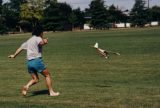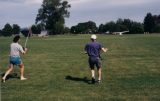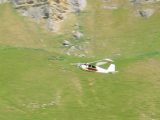
|
"Petite Dreaming 850"
ARF kit by Kyosho
|
Specifications
|
Wingspan
|
890mm (35")
|
|
Wing Loading
|
45gm/dm
2
(15 oz/sqft)
|
|
Flying Weight
|
560gm (20oz)
|
|
CG (percent of MAC)
|
34%
|
|
Motor
|
Johnson RE380 (equiv. Speed 400 6V)
|
|
Propeller
|
Gunther 5"x4.3"
|
|
Speed Control
|
10A with BEC and brake
|
|
Battery
|
6 x Sanyo KR600AE NiCad (7.2V)
|
|
Receiver
|
Hitec HS-04Mi
|
|
Servos
|
2 x Cirrus CS20
|
|
Controls
|
Ailerons, Elevator, Motor
|
|
Construction
|
ARF (prebuilt balsa wing, blow-moulded plastic body)
|
This was my first electric-powered model plane (a present for my 42nd birthday
on Nov 1st, 1999 - thanks Ian!). It was quite easy to assemble (as might be
expected from an ARF design), despite Japanese-only instructions. I installed
an old 29MHz AM radio that I had lying around, but with very light sub-micro
servos in place of the suggested standard units.
As I had not flown an R/C plane since the early 1980's, I was quite nervous
about flying it. For its maiden flight I went out to the local park, with my
brother Peter assisting while my friend Wayne recorded the event on film.
Prelaunch checks indicated that I had the aileron servo linkages backwards, but
I was too impatient and decided to fly anyway!

At first I tried ROG, which failed due to lack of a rudder (controls were
ailerons and elevator only). Instead of taking off it simply groundlooped. So
we decided to handlauch, with me controlling the transmitter while my brother
launched the plane. He threw it, softly - whereapon it rapidly entered an
attitude of 45 degrees downwards! OK, so now it didn't have an undercarriage
anymore...

My next plan was to swap roles. I would launch the model while my brother held
the transmitter, then he could hand me the Tx once the plane was aloft. We
tried this several times, but I always 'lost the plot' shortly after taking
control. Eventually the plane was too broken to continue flying.
A few days later, after repairing the motor and undercarriage, patching up
cracks in the body and reversing the aileron linkages, I was ready for another
go. Thus started a familiar ritual of fix-fly-bust, and my goal became to see
if I could keep it in the air long enough for the motor cutout to activate
(just over 1 minute!).
This plane flies alarmingly fast for a beginner, and I never seemed to get very
far out before losing control. Eventually I found out why. When doing a
moter-on range check(!) I discovered that my old AM receiver was picking up
noise from the motor brushes, reducing effective range to only 50 Metres. So I
bought a new Hitec 'Flash 4' FM radio set, which solved the interference
problem. Finally I was able to control the thing properly, and started to gain
some confidence and improve my flying skills.
I also made a few other improvements, including a graupner 6" x 3" folding prop
and a proportional speed controller. The supplied 5 cell battery pack was not
achieving expected capacity (I suspect this kit had sat on the dealer's shelf
for several years), so I built new battery packs with Sanyo KR600AE cells. This
increased motor run-time from 1 minute to 3 minutes!
 Even with these better batteries, flight performance was still marginal.
Motorcalc indicated that Kyosho's AP-29 motor was too big for this plane. Apon
replacing the motor with a Johnson 380 (equivalent to a 6 Volt Speed-400), a 6
cell battery pack and a Gunther 5" x 4.3" prop, flight time increased to 6
minutes. Despite the less powerful motor, climb rate actually improved
slightly. I also made up a 7 cell battery pack, which makes flights more
lively, but reduces motor run-time to just over 5 minutes.
Even with these better batteries, flight performance was still marginal.
Motorcalc indicated that Kyosho's AP-29 motor was too big for this plane. Apon
replacing the motor with a Johnson 380 (equivalent to a 6 Volt Speed-400), a 6
cell battery pack and a Gunther 5" x 4.3" prop, flight time increased to 6
minutes. Despite the less powerful motor, climb rate actually improved
slightly. I also made up a 7 cell battery pack, which makes flights more
lively, but reduces motor run-time to just over 5 minutes.
back



